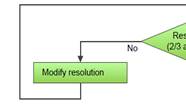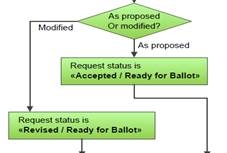Thanks Marek and Glen for the clarifications.
The item that I was afraid of is the one that Glen pointed,
“In
an (unlikely) event that RMTF misunderstood the problem and adopted a resolution that did not fix the problem, the submitter can always submit another request.”, and it
clarified.
Rgrds
--Raz
From: Glen Kramer [mailto:gkramer@xxxxxxxxxxxx]
Sent: Thursday, September 04, 2014 7:07 PM
To: Marek Hajduczenia; Raz Gabe
Cc: STDS-1904-WG@xxxxxxxxxxxxxxxxx
Subject: RE: maintenance process
Raz,
I am not sure what such negotiation with the submitter would achieve. If the RMTF agreed on a resolution, but the submitter does not approve it, should the
TF find another resolution?
I think the key point is that once the MR is submitted, it is not “owned” by the submitter anymore. It is owned by the RMTF. The submitter may be consulted
for additional clarifications, if RMTF finds it necessary. Also, the submitter should be informed of the final status of the MR (Rejected/Accepted/Revised) with necessary explanations, but he/she should not have any veto power or any special leverage over
the work of the TF. In an (unlikely) event that RMTF misunderstood the problem and adopted a resolution that did not fix the problem, the submitter can always submit another request. As the RMTF needs 2/3 votes to adopt a resolution, so it can open the previously-resolved
MR and revise its resolution with 2/3 votes.
The submitter will have several opportunities to influence the text that goes into the revised standard. The first opportunity is to participate in the work
of RMTF, and thus participate in the resolution of his/her own request, as Marek said.
Another opportunity is to join the sponsor ballot on the revised standard and submit ER/TR there.
The key is that the submitter influence is the same as that of any other member of the group and there is no special privileges.
We should discuss this more at the meeting.
Glen
From: Marek Hajduczenia
[mailto:marek.hajduczenia@xxxxxxxxx]
Sent: Thursday, September 04, 2014 4:17 AM
To: Raz Gabe
Cc: Glen Kramer; STDS-1904-WG@xxxxxxxxxxxxxxxxx
Subject: Re: maintenance process
Raz,
I think that step represents precisely what you're asking for - the step of "Modify resolution" implies any process(es) we typically use to reach consensus, including discussions between the task force and the submitter (via email, phone, etc.). As a side note,
a submitter is always encouraged to participate in the MR resolution to make sure that the feedback and discussions are all done in a timely manner.
Once the MR is moved to the "Ready for Ballot" status, at least 2/3 of the Task Force have been satisfied and I believe there is no need for further "negotiation" with the submitter - the MR will be then balloted,
where individual have another shot at the MR, suggesting any changes they might deem necessary.
I think we are good as shown today
Thanks for looking at it
Marek
On 4 September 2014 01:34, Raz Gabe <Raz.Gabe@xxxxxxxx> wrote:
Thanks Glen,
Looks OK from my point of view with one comment.
I think that there should be an option of negotiation/approval between the committee and the submitter.
·
At the step

·
And also at the last steps after modified/revised:

Rgrds
--Raz
From:
stds-1904-wg@xxxxxxxx [mailto:stds-1904-wg@xxxxxxxx]
On Behalf Of Glen Kramer
Sent: Thursday, September 04, 2014 3:37 AM
To: STDS-1904-WG@xxxxxxxxxxxxxxxxx
Subject: maintenance process
Dear colleagues,
At the last meeting, I took an action item to revise the maintenance process to decouple handling of maintenance requests and balloting on draft standard.
Attached please, see the proposed maintenance process diagram. Please, let me know if you have any feedback.
Thank you,
Glen